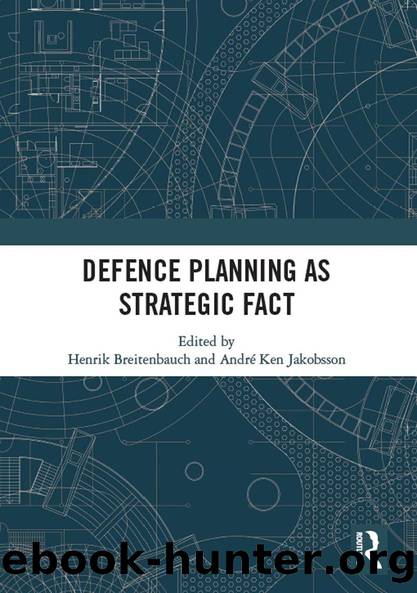Defence Planning as Strategic Fact by Henrik Breitenbauch André Ken Jakobsson

Author:Henrik Breitenbauch, André Ken Jakobsson [Henrik Breitenbauch, André Ken Jakobsson]
Language: eng
Format: epub
Tags: Nonfiction, Social & Cultural Studies, Political Science, International, International Security, History, Military, Strategy
ISBN: 9781000732177
Publisher: Taylor and Francis
Published: 2020-06-04T04:00:00+00:00
Research design and analytical tool
Intentionally, I approach the theory from the perspective of identifying conditions, rather than to try to treat them as separate independent variables. It is too early and it would require a different research design, if the ambition were to test these factors in order to identify the explanatory power of each of them. Most importantly, it would require a comparative design. However, in this article, I only expand on one case study in order to develop the causal mechanisms. Below I will develop the analytical tool and briefly elaborate on a few methodological issues.
First, as discussed above the four conditions considered in this article are (1) separation of the power to wage war from the power to create, fund and organize military capabilities, (2) a separation of the processes for long-term planning, military acquisition, and the formulation of political ends, (3) a representation of future war as a narrowly understood military undertaking, and (4) a representation of the future as deterministic and without agency. All of these conditions, as seen in Table 1, can be interpreted at least in binary terms, i. e. there are at least two possible outcomes for each of the conditions.
Second, the distribution of power in the decision-making process will be ascertained by an analysis of the formal decision-making procedures. This approach has its weakness considering that it cannot capture informal decision-making processes or the impact of political culture. The approach, however, is not without merits since the formal rules still set the stage for the decision-making.
Third, the representation of future war is ascertained through contents analysis of the key strategic futures documents such as DoD:s Quadrennial Defense Review, Joint Chiefsâ Joint Visions as well as the National Intelligence Councilâs so-called Global Trends. Although there are far more documents that are important in the US defense planning process, these documents, arguably, cover key issues relating to how US strategic elites conceive the future of war. An in-depth reading of these documents thus reveals how the âfutureâ is understood and how this idea shapes the understanding of future war. The Quadrennial Defense Review as Tama (2018) outlines in great detail, was issued by the DoD every four years during the Bush and Obama presidencies aiming to present to the Congress, the administrationâs overall strategy and explain how political ends were met with certain demands of force structure and acquisition plans. As such, the document series was important for the short-term defense planning process, although it should be noted that some long-term modernization and acquisition programs ran almost independently of the QDR since development of significant platforms such as main battle tanks, destroyers or fighters takes longer than four year cycles. Even if there is also planning in the different services, the Joint Chiefsâ documents on future war, the so-called Joint Vision is an authoritative source for how US armed forces understand and represent future war. The Joint Vision considers the future of war in the 10â20 year future, which means that it both
Download
This site does not store any files on its server. We only index and link to content provided by other sites. Please contact the content providers to delete copyright contents if any and email us, we'll remove relevant links or contents immediately.
| Africa | Americas |
| Arctic & Antarctica | Asia |
| Australia & Oceania | Europe |
| Middle East | Russia |
| United States | World |
| Ancient Civilizations | Military |
| Historical Study & Educational Resources |
Machine Learning at Scale with H2O by Gregory Keys | David Whiting(4258)
Never by Ken Follett(3882)
Fairy Tale by Stephen King(3307)
The Man Who Died Twice by Richard Osman(3040)
Oathbringer (The Stormlight Archive, Book 3) by Brandon Sanderson(3019)
Will by Will Smith(2872)
Rationality by Steven Pinker(2327)
The Dark Hours by Michael Connelly(2279)
Can't Hurt Me: Master Your Mind and Defy the Odds - Clean Edition by David Goggins(2276)
Friends, Lovers, and the Big Terrible Thing by Matthew Perry(2182)
The Dawn of Everything: A New History of Humanity by David Graeber & David Wengrow(2156)
Principles for Dealing With the Changing World Order: Why Nations Succeed and Fail by Ray Dalio(2006)
HBR's 10 Must Reads 2022 by Harvard Business Review(1820)
A Short History of War by Jeremy Black(1816)
Go Tell the Bees That I Am Gone by Diana Gabaldon(1731)
A Game of Thrones (The Illustrated Edition) by George R. R. Martin(1661)
515945210 by Unknown(1642)
Kingdom of Ash by Maas Sarah J(1594)
443319537 by Unknown(1522)
